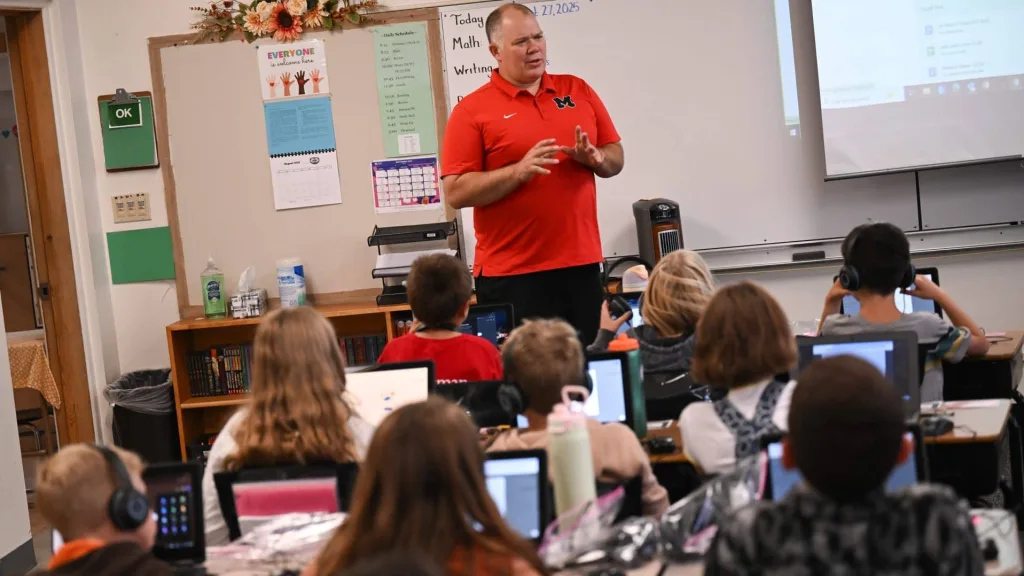Originally posted on IdahoEdNews.org on September 14, 2025
EDITOR’S NOTE: A third-grade teacher is a third-grade teacher, whether they’re in Bonners Ferry or Boise. It’s not the same for superintendents, whose tasks may vary from lobbying the Legislature to driving a school bus, depending on the district. That breadth of work makes hiring and retaining superintendents difficult in Idaho.
To illustrate the differences, EdNews spent a day with a superintendent in a small town and a superintendent in a mid-sized, college town.
MOSCOW, ID – Superintendent Shawn Tiegs walked off the paper red carpet and plopped down on the rug to line up Batman figures with first-graders.
It was the last half hour of the first day of school at West Park Elementary.
Parents in cars had already begun lining up in front of the school that is practically a part of the University of Idaho campus.
For Tiegs, the classroom stop was a chance to do what he likes the most: hang out with kids.
It’s something he gets to do less and less now that he has taken over managing one of North Idaho’s largest school districts.
On this first day of school, he woke at 5 a.m. to reply to text messages, check with principals and get his own kids ready for school. Then he buzzed from building to building to make sure his principals got a good start to the day.
Tiegs’ days are normally full of meetings, which he tries not to hold in his office in the converted historic building next to the middle school. Instead, he likes to travel from one of Moscow’s six school buildings to the next.
“I continue to maintain awareness of every situation but I’m not always like the front-line person,” Tiegs said.
In the two years he has worked in Moscow, Tiegs said he has focused on being a strong communicator and keeping everyone on the same page, as his team of administrators at the district office and the schools manage day-to-day operations.
Previously, Tiegs spent five years as the superintendent in Nezperce, a district of about 170 students.
There, he could meet with his entire staff and get feedback in one day, but in Moscow, change is “slower and it also requires attention to the communication.”
He recalls the early days in Moscow when he was still in the “let’s just get this done” mindset of Nezperce and would make decisions only to realize he didn’t have the right three people in the room, who would be impacted by the plan and would implement it.
He has since learned it often takes more than one meeting to get something done in a bigger district.
About Moscow
Moscow, nestled on the Palouse, is home to the University of Idaho and just a short drive to Washington State University, making the area a blend of farming families, blue-collar workers and people working in academia.
For Tiegs, the new demographics were a shift from Nezperce, where most people agreed on most things.
“There’s actually a very wide, diverse set of opinions,” Tiegs said of Moscow.
That mix of opinions, Tiegs said, has created compromise and community.
“That is the beauty of public school. … We don’t ask you what party you’re a part of, or what church you attend, or where you came from,” Tiegs said. “We are just here to educate all of us, and we put all of us in the same room.”
Moscow has one high school, a middle school, three elementary schools, an alternative high school and a K-8 charter school. The area also has what Tiegs describes as a robust variety of private and charter school choices, most only going through eighth grade.
“There’s this idea that they’re all the same kids heading to the high school,” Tiegs said. “We’re all aiming for our kids being Moscow Bears in grades 9-12.”
The single high school brings the community together, Tiegs said.
Moscow is one of only six Idaho districts with an ongoing levy. Moscow voters have approved an increase to levy five times, the most in state history.
Those funds help Moscow compete with nearby Washington for teachers. Still, educators could drive 15 minutes, and in some cases they can make $20,000 more a year.
Even with the increased funds and community support, Tiegs said money is a big stressor.
“This feeling like you are playing with other people’s money and you’re trying to do a good service to all of us,” Tiegs said.
Tiegs is grateful his trustees are experienced, and they livestream board meetings and post recordings, which he credits for creating community trust.
In turn, Board Chair Ken Faunce said Tiegs has been an extremely active leader.
“To me, it’s amazing that he remembers so many of the kids names,” Faunce said. “He’s really hands-on, he’s in the schools regularly talking to all the administrators the staff.”
The trustees initially were concerned Tiegs would struggle to adapt to a larger district, Faunce said.
“We were worried that he would want to be involved in every little detail because in a smaller district you have to be like that but you can’t do that in Moscow,” Faunce said.
But Faunce said, Tiegs has delegated well and always keeps the big picture at the forefront.
Moscow statistics
Students: 2,115.
School buildings: Six.
Teachers: 140.
Annual Budget: $28.8 million.
‘Your job is to truly listen’
By mid-afternoon on the first day of school, Tiegs made it back to his office, crammed full of bear stuffed animals and family photos. He choked down a cup of coffee before heading back out to the schools.
For Tiegs, who always wanted to be a teacher, being a superintendent isn’t what he planned.
Tiegs, 46, grew up on the Palouse with four siblings. His father was his sixth-grade teacher and his mother his seventh-grade teacher.
He married a fellow math tutor he met while earning his undergraduate degree in math at Lewis-Clark State College.
Tiegs had gone to college thinking he wanted to be a teacher. But his desire to raise a big family of his own pushed his educator parents to suggest a different path, maybe engineering.
“Being a teacher you just get beat up by the public, it’s never enough,” Tiegs recalls his parents telling him.
He worked at an area lumber mill to provide for his growing family, but quickly decided to become a teacher. He was one of the first in the state to complete the American Board for Certification of Teacher Excellence (ABCTE) program.
Tiegs taught for six years in the Highland School District, then moved to Nezperce when the longtime science teacher retired.
In 2013, Tiegs received the Albert Einstein Distinguished Educator Fellowship, a chance to work and live in Washington, D.C., and help steer STEM education nationwide. Tiegs hauled his first five children back east for a life-changing experience.
“I love teaching, I love coaching but I think I kind of want to be at a bigger table that can impact more people and have a voice,” Tiegs said.
The fellowship put him on a path to school administration. He served as Nezperce principal for two years before becoming superintendent.
“These small school principals and superintendents, it’s one of the toughest jobs in education,” Tiegs said. “You’re by yourself.”
Tiegs, now a father of seven, said it would be impossible to do the superintendent’s job without his wife staying home with their children.
“It’s just this constant kind of, ‘you need to be available,’” he said.
He’s one of the few mid-career superintendents in the state planning to stick around, according to an EdNews survey. His youngest daughter, who he calls his “anti-retirement plan,” is 3 years old, and Tiegs plans to stay in public education until she graduates.
The shift to Moscow, Tiegs said, has changed things in some ways but not in a major way. He’s still on call all the time. Just now, his job is more about looking at the district from the 30,000-foot level.
“Your job is to truly listen and hear those other people,” Tiegs said.
As parents picked up their kids on the first day of school and teenagers scampered off to practices, Tiegs headed back to the office. He had an evening school board meeting to prepare for.





